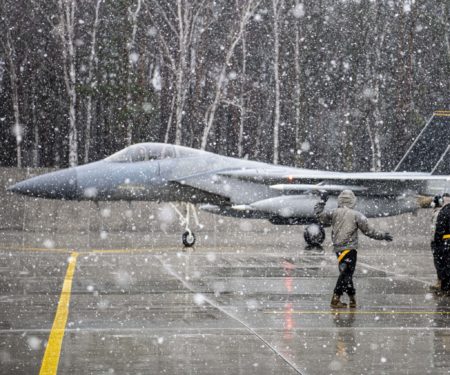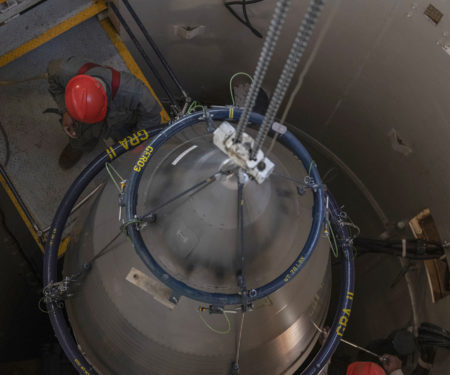Radar Sweep
Russia Sends Warplanes to Syria for Huge Naval Drills in Med
The Russian military on Feb. 15 deployed long-range nuclear-capable bombers and fighter jets carrying state-of-the-art hypersonic missiles to its air base in Syria for massive naval drills in the region amid soaring tensions with the West over Ukraine. Russian Defense Minister Sergei Shoigu arrived in Syria to oversee the drills that mark the biggest Russian naval deployment to the Mediterranean Sea since Cold War times. Shoigu met with Syrian President Bashar Assad to inform him about the drills and discuss plans for further military-technical cooperation.
‘Lead Wing’ Plan for Air Force Deployments Takes Shape at Nine Bases
The Air Force’s blueprint for deploying more responsive, better-trained teams is coming into focus this year, as 10 wings across the service, including two at one base, prepare for new roles in combat operations. January’s announcement of which units will act as “lead wings”—the main group in charge of a team of aircraft from different bases and wings—sheds light on how the service views future air warfare: a guessing game without safe havens that requires far more collaboration among Airmen than in the past.
China Proposes Formal Lines of Communication With US on Space Safety
The Chinese government is open to establishing formal lines of communication with the United States on space safety issues after a pair of alleged close calls of Starlink satellites with China’s space station. At a Feb. 10 press conference, Zhao Lijian, spokesman for China’s Ministry of Foreign Affairs, reiterated claims the country made to the United Nations in December that it had to maneuver its space station twice in 2021 to avoid close approaches by SpaceX Starlink satellites.
New GPS Simulator Will Support US Air Force Swarming Munitions Testing
The U.S. Air Force is integrating a new GPS simulator at its Guided Weapons Evaluation Facility to support testing of the service’s swarming munitions program, Golden Horde. The service has selected Orolia Defense and Security’s BroadSim Wavefront simulator to help test electronic protection technology at the Guided Weapons Evaluation Facility, which is located at Eglin Air Force Base, Fla. Orolia didn’t disclose the value of the contract.
WATCH: Understanding and Developing Autonomy in Unmanned Aircraft
The Mitchell Institute for Aerospace Studies invites you to watch the rollout for its newest policy paper: “Beyond Pixie Dust: A Framework for Understanding and Developing Autonomy in Unmanned Aircraft” by Heather Penney, senior resident fellow. She is joined by Jean-Charles Ledé, commander’s autonomy technical adviser at the Air Force Research Laboratory, and Maj. Christopher C. Olsen, military deputy at the Office of the Air Force Chief Software Officer.
Oracle’s Cloud Can Now Host Select Top Secret Defense Data
Oracle announced Feb. 15 that it can now host some of the U.S. federal government’s top secret/sensitive compartmented information (TS/SCI) and special access program mission data in its Oracle Cloud Infrastructure platform. According to the company, Defense Department assessors granted it an authority to operate for secure processing of some of the Air Force’s most sensitive data in what the company calls Oracle National Security Regions. These air-gapped computing regions are connected only to government networks and not to the rest of the internet.
US B-52 to Integrate With Singaporean A330 MRTT
A U.S. Air Force Boeing B-52 bomber will link up with a Republic of Singapore Air Force Airbus A330 Multi-Role Tanker Transport (MRTT) on Feb. 17 as part of a broad U.S.-partner push to expand the ability of aircraft to receive fuel from tankers of international operators. The B-52 is coming to the region for a display at the Singapore Airshow and will fly with the A330, separately, from the event. The B-52 will not connect with the tanker, but it is an early step toward certifying the nuclear bomber with the Singaporean refueler, said U.S Air Force Gen. Kenneth Wilsbach, commander of Pacific Air Forces.
OPINION: To Get Better at AI, Get Better at Finding AI Talent
“The Defense Department’s recent efforts to raise its artificial intelligence game have revealed a few obstacles. There are no cohesive goals across the military branches, and there is no way of knowing whether each service has enough people with the right skills. DOD should work with the services to establish AI-specific goals for cultivating technical talent, make it easier for all personnel to learn about AI and put it to use, and enable AI ‘rock stars’ to succeed,” writes Diana Gehlhaus, research fellow at Georgetown University’s Center for Security and Emerging Technology.
Air Force Paying to Prevent ‘Lunar Traffic Jams'
An Air Force research initiative is spending $7.5 million to head off the problem of "lunar traffic jams"—a potentially deadly hazard for the new generation of manned moon missions set to launch throughout the 2020s. The collaboration between the Air Force Research Laboratory and University of Arizona will start by mapping the dozens of natural and human-made artifacts in the “chaotic environment" of lunar orbit.
Space Force to Examine U.S. Military Needs for Low-Orbiting Surveillance Satellites
Air Force Secretary Frank Kendall has directed the Space Force to look broadly at military requirements for overhead surveillance that could be met by commercial constellations of satellites in low Earth orbit. The use of commercial space services for military ISR (intelligence, surveillance, and reconnaissance) is a growing conversation as battlefield commanders demand more reliable and timely data.
Dynetics Selected for the Second Phase of DARPA’s ACE Program
Dynetics, a wholly owned subsidiary of Leidos, has been selected for Phase 2 of the Air Combat Evolution (ACE) program, Technical Area 3 (TA3), by the Defense Advanced Research Projects Agency's (DARPA) Strategic Technology Office (STO). ACE TA3, also known as AlphaMosaic, seeks to develop and demonstrate a battle management capability driven by artificial intelligence (AI). In the 16-month Phase 2 contract valued at $2.6 million, Dynetics will continue to develop a matured approach to battle management, where a single pilot can act as a commander for large-scale, collaborative air warfare.
Inside the Intense Training Airmen Go Through to Fly the Largest Ski Plane in the World
Let it be said that the C-130 Hercules can do just about anything. It serves as a gunship, a weather plane, an aerial refueling tanker, a command and control hub, and as an old-fashioned transport. But one of its unusual jobs is less about how the Herc flies and more about how it lands: on ice and snow using skis as landing gear.



